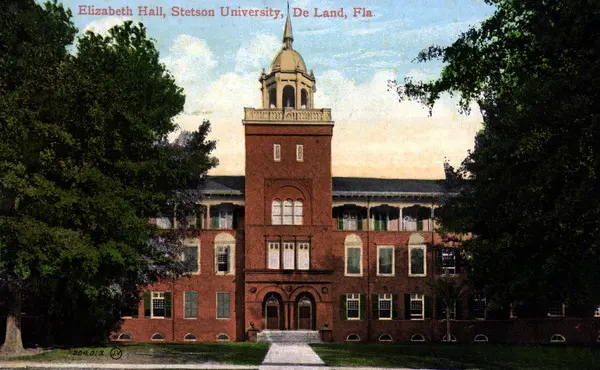In 1876, businessman Henry A. DeLand left his home in Fairport, New York, to visit his sister and brother-in-law in east central Florida. DeLand’s relatives, Mr. and Mrs. O.P. Terry, had created a rural homestead in west Volusia County.
Henry DeLand left New York on a train to Jacksonville. From there he took a steamboat down the St. Johns River to Enterprise. A horse and buggy carried him the rest of the way to the Terry’s isolated home. DeLand was so impressed with the beauty and climate of the area that he decided to start a town there.
Using the fortune he had accumulated from manufacturing baking soda in New York, DeLand purchased large tracks of land near the Terry homestead. The area was called Persimmon Hollow, but when the scattered settlers heard about DeLand’s plans to establish a town, they voted to name it after him. To entice others to settle in his new town, DeLand made a generous offer.
Henry DeLand told people that if they moved to his town and decided that they were unhappy there, he would buy back the land that he sold to them.
Families started moving to the town of DeLand, most growing citrus or other crops. Henry DeLand nicknamed his town “The Athens of Florida,” and worked to foster cultural, religious, and educational opportunities for residents.
The town prospered quickly. DeLand built a public school that also served as the meeting hall for churches, until each denomination could build their own houses of worship. He brought in entertainers and sponsored special events. In 1883, a college called the DeLand Academy was established.
One of DeLand’s friends who also contributed greatly to the development of the town was the famous hat manufacturer John B. Stetson. By 1889, Stetson had contributed so much time and money to the development of the DeLand Academy that the name of the institution was changed to Stetson University.
Stetson University’s DeLand Hall was the first building constructed on the campus and is the oldest building in Florida continuously used for higher education. Elizabeth Hall, the focal point of the school, was named after Stetson’s wife.
In 1886, A.G. Hamlin bought property from Henry A. DeLand that was located across the street from the college campus. Hamlin was DeLand’s first attorney and developer of the Hamlin orange. The seedless, smooth-skinned Hamlin orange is still popular for both juice and eating.
Today, Hamlin’s former home is the DeLand House Museum and the headquarters of the West Volusia County Historical Society.
A fire burned much of downtown DeLand in 1886. The fire started in Wilcox’s Salon and destroyed the 100 block of Woodland Boulevard on both sides. Following the blaze, the town passed an ordinance that allowed only brick buildings to be constructed in the commercial district. Many wooden homes that survived the fire still stand in DeLand.
The town quickly rebounded from the devastating fire and life returned to normal. The people who DeLand had encouraged to settle in his town remained happy.
Then came the Big Freeze of 1894-95.
Twice during that unusually cold winter, temperatures in Central Florida fell as low as 11 degrees, killing nearly all of the area’s orange crops. Farmers living in DeLand were left with no produce to sell, and were no longer content.
To his credit, Henry DeLand kept his promises. By the time he died in 1908, DeLand had bought back all of the land he had sold from any settlers who did not want to remain in the area. DeLand lost his fortune, as well as his large home in Fairport, New York.
The Henry A. DeLand House in Fairport, also known as the Green Lantern Inn, is now a catering hall listed on the National Register of Historic Places.
The DeLand House Museum is located at 137 W. Michigan Avenue in DeLand, Florida. Tours are available Tuesday through Saturday from noon to 3:00 pm.
Dr. Ben Brotemarkle is executive director of the Florida Historical Society and host of the radio program “Florida Frontiers,” broadcast locally on 90.7 WMFE Thursday evenings at 6:30 and Sunday afternoons at 4:00, and on 89.5 WFIT Sunday mornings at 7:00. The show can be heard online at myfloridahistory.org.


